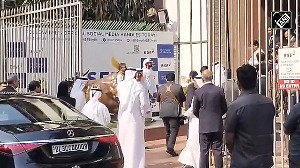Military sources said the parameters drawn up in support of the sniper rifle requirement in the tender issued in August 2009 appear to have been by framed by ill-informed officers with seemingly little or no field experience, says Rahul Bedi
Trials to import around 900 bolt-action sniper rifles for the Central Reserve Police Force for an estimated Rs 20 crores are scheduled to be held early in the new year to bolster its insurgency-fighting capability.
Official sources said at least five vendors -- including Germany's Walther, Switzerland's Brugger and Thomet, South Africa's Truvelo, Italy's Sako/Baretta and a Czech manufacturer -- are vying for the tender dispatched a year ago.
Security officials said competitive trials where all five models would be test-fired to a range of 800-1000 metres would take place at the CRPF's Kaderpur firing range in Haryana on the Delhi-Sohna road.
The acquisition is being re-tendered after an earlier attempt by the CRPF to acquire 807 sniper rifles -- 433 bolt-action and 374 semi-automatic models -- was summarily rejected last year after the Qualitative Requirements for the weapon system were rejected on operational grounds.
Brugger & Thomett, Russia's Rosoboronexport, Germany's Heckler & Koch and Truvelo were competing for this contract, the QRs for which were drawn up by the paramilitary's forces' ill-informed and amateurish planners.
The QRs for the re-tendered sniper rifles, however, have been finalised by sharp-shooters from the National Security Guard who regularly practise their marksmanship and related disciplines on their 180-odd H&K PSG1A1 weapons inducted into service shortly after their raising in 1986.
After the November 2008 Mumbai terrorist strike by Pakistan-launched gunmen, the operational efficacy of sniping has gained credence among India's security and law enforcement agencies as they endlessly battle foreign terrorists, unrelenting insurgencies and armed separatist movements.
The failure of the administrations' tentative and inchoate strategy of large-scale paramilitary and police deployment against wily Naxalite cadres was gradually shifting tactical thinking in the direction of developing a surgical killing capacity via snipers.
Security planners said the CRPF in the vanguard of the fight against the Naxalite-spawned "Red Terror" needed these sophisticated rifles in this seemingly unending and proliferating guerilla war.
The Naxal-favoured forest terrain of areas like Chhattisgarh, where their top leadership was reportedly secreted, was a conflict zone ideally suited to snipers.
"If adequately trained and equipped and judiciously employed, CRPF sharpshooters could effectively depreciate the Maoist hierarchy," a senior federal security official said.
Meanwhile, the ministry of defence and army were plagued by inordinate delays in procuring sniper rifles which were to have been acquired via the special fast track procurement route over a year ago.
The deadline under the FTP -- specially introduced by the MoD to short-cut cumbersome procurement procedures -- to finalise the import of 900-1000 sniper rifles for the Special Forces concluded last December with Finland's bolt-action SAKO TRG-22/24, Israel Weapon Industries semi-automatic Galil 7.62x54mm sniper model and Sig Sauer of USA's SSG 3000 bolt-action, magazine-fed rifle, competing for the $ 10-12 million contract.
Comparative trials were conducted in late 2009 in the respective countries by an Indian army team led by a two-star officer and additional orders were anticipated to augment India's anti-insurgency operations.
Sig Sauer, however, under a special albeit inexplicable waiver granted by Defence Minister AK Antony was permitted to conduct firing trials at the Infantry School in Mhow in April.
But defence industry sources said even then its SSG 3000 model was not tested to the optimum range of 800-1000 metres in both day and night conditions and was reportedly wrangling to secure yet another MoD waiver in this regard, resulting in delays in confirming the sniper rifle purchase.
Military sources said the army's QRs drawn up in support of the sniper rifle requirement in its tender issued in August 2009 appear to have been by framed by ill-informed officers with seemingly little or no field experience.
Surprisingly, the QR mandated no accuracy standard for the sniper rifles at a minimum strike range of 800 mt -- the fundamental requirement for such a weapon system -- but absurdly requires them to be fitted with a bayonet.
It is incomprehensible as to why the QR, that requires the rifle for employment at a distance of over 800 mt, needs a bayonet which is a close quarter combat weapon.
It seems the Infantry Directorate anticipates a comic situation in which a sniper actually bayonet-charges the enemy.
Additionally, the sniper rifles tender also does not differentiate between a bolt action or semi-automatic model.
Instead, it demands a vague capability, requiring the rifle to fire either one or five rounds, a facility open to interpretation by vendors producing either of the two versions to suit their individual commercial interests.
Alongside, the purchase of 1200-1300 9mm submachine guns for select "Ghatak" infantry commando platoons and 1.3 million rounds of accompanying ammunition initiated two years ago also under FTP procedures, too awaits closure.
Switzerland's Brugger & Thomet, Israel Weapon Industries and H&K were vying for the contract estimated at around $ 4.44 million, trials for which were conducted months ago in all three countries.
The MoD has also recently initiated emergency measures to import some 66,000 125 mm armour piercing fin-stabilised discarding sabot (APFSDS) rounds from Russia for its T-72M1 main battle tanks on grounds of 'operational necessity'.
This followed the recent intimation by the army that its war wastage reserves of 125mm rounds for its T72M1s that form the backbone of its 60-odd armour regiments had fallen below 'critical levels'.
MoD sources said the emergency procurement reportedly at 'inflated prices' also obliged it to waive the offset obligation of 30 per cent mandated for all Indian military purchases over Rs 3 crores.







 © 2025
© 2025